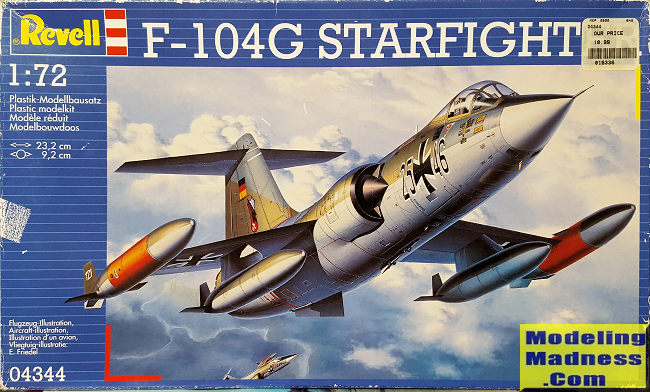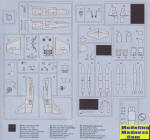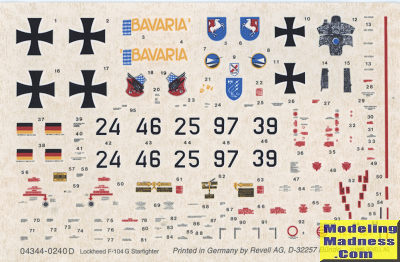
Revell 1/72 F-104G Starfighter
| KIT #: | 04344 |
| PRICE: | $1.00 at auction |
| DECALS: | Three options |
| REVIEWER: | Scott Van Aken |
| NOTES: | 1995 release |

| HISTORY |
The Lockheed F-104 Starfighter is a single-engine, supersonic interceptor aircraft which was extensively deployed as a fighter-bomber during the Cold War. Initially created as a day fighter by Lockheed for the United States Air Force (USAF) as one of the Century Series of fighter aircraft, it was developed into an all-weather multirole aircraft in the early 1960s and produced by several other nations, seeing widespread service outside the United States. After a rocky start with NATO nations in terms of crashes, the F-104 went on to become a fairly successful fighter. An upgraded version was built by Italy as the F-104S.
| THE KIT |
 This is not, of course, the
first F-104 kit produced in this scale. After being done by several companies,
including Hasegawa, the Japanese company did a new tooling in 1989 that
became the industry standard for the type. Revell released their version in this
scale in 1995 and while it is very nice, many modelers still think the Hasegawa
variant is the best.
This is not, of course, the
first F-104 kit produced in this scale. After being done by several companies,
including Hasegawa, the Japanese company did a new tooling in 1989 that
became the industry standard for the type. Revell released their version in this
scale in 1995 and while it is very nice, many modelers still think the Hasegawa
variant is the best.
Revell's kit is typical of the type in that the front and rear fuselages are separate. This allows for a two seat version to be done, and Revell did release one. The kit does have a separate rear fin so that the early F-104A/C can be done and indeed, Revell does/did kit this early version.
The kit does provide two seat styles; the Lockheed and a Martin Baker seat. Both markings options use the Lockheed version. Typical of kits of this sort, the nose gear well fits under the cockpit. The instructions give you the option of opening various holes in the forward fuselage. One set is for the fuselage mounted missile pylons, but the instructions never show them being installed. The other is for a rather odd forward fuselage strake that I've never seen on an F-104 before, but is shown on the box art. It is possible that this is supposed to be a pylon for the recce pod.
After attaching the intakes to the forward fuselage,
construction turns to the rear with the extended rudder piece and exhaust being
assembled. This then fits onto the assembled rear fuselage sections. Note that
this section has the blanking plate for the intakes. Speed brakes can be posed
open or closed as you wish. Then it is on to building the main landing gear well
assembly. This completed section is then slid into the fuselage before the front
and rear sections are joined and the gear doors put on. The last bits are the installation of the wings, canopy and pylons as well
as the building of the four fuel tanks; two on the wing tips and two on the
pylons.
on. The last bits are the installation of the wings, canopy and pylons as well
as the building of the four fuel tanks; two on the wing tips and two on the
pylons.
Instructions are nicely done and provide the usual Revell of Germany paint references and any mixing ratios required. The three markings options are all in the early splinter camouflage scheme of green/grey uppers and silver undersides with day-glo bands on the tip tanks. The box art plane is from JBG 32 with the other two from JG 74 and JBG 36. The fairly large decal sheet is nicely done though it is quite matte and has large clear surrounds which will benefit from trimming. Due to the age of the sheet, it would be wise to find aftermarket.
| CONCLUSIONS |
This looks to be a nice kit, though not having built it I really cannot comment on its ease of construction. The Hasegaw kit still looks nicer to my eyes, but this one is more easily available and is probably less expensive by a few dollars.
| REFERENCES |
https://en.wikipedia.org/wiki/Lockheed_F-104_Starfighter
June 2023 Copyright ModelingMadness.com. All rights reserved.
No reproduction in part or in whole without express permission from the editor. If you would like your product reviewed fairly and fairly quickly, please contact the editor or see other details in the
Note to
Contributors. Back to the Main Page
Back to the Review
Index Page
Back to the Previews Index Page